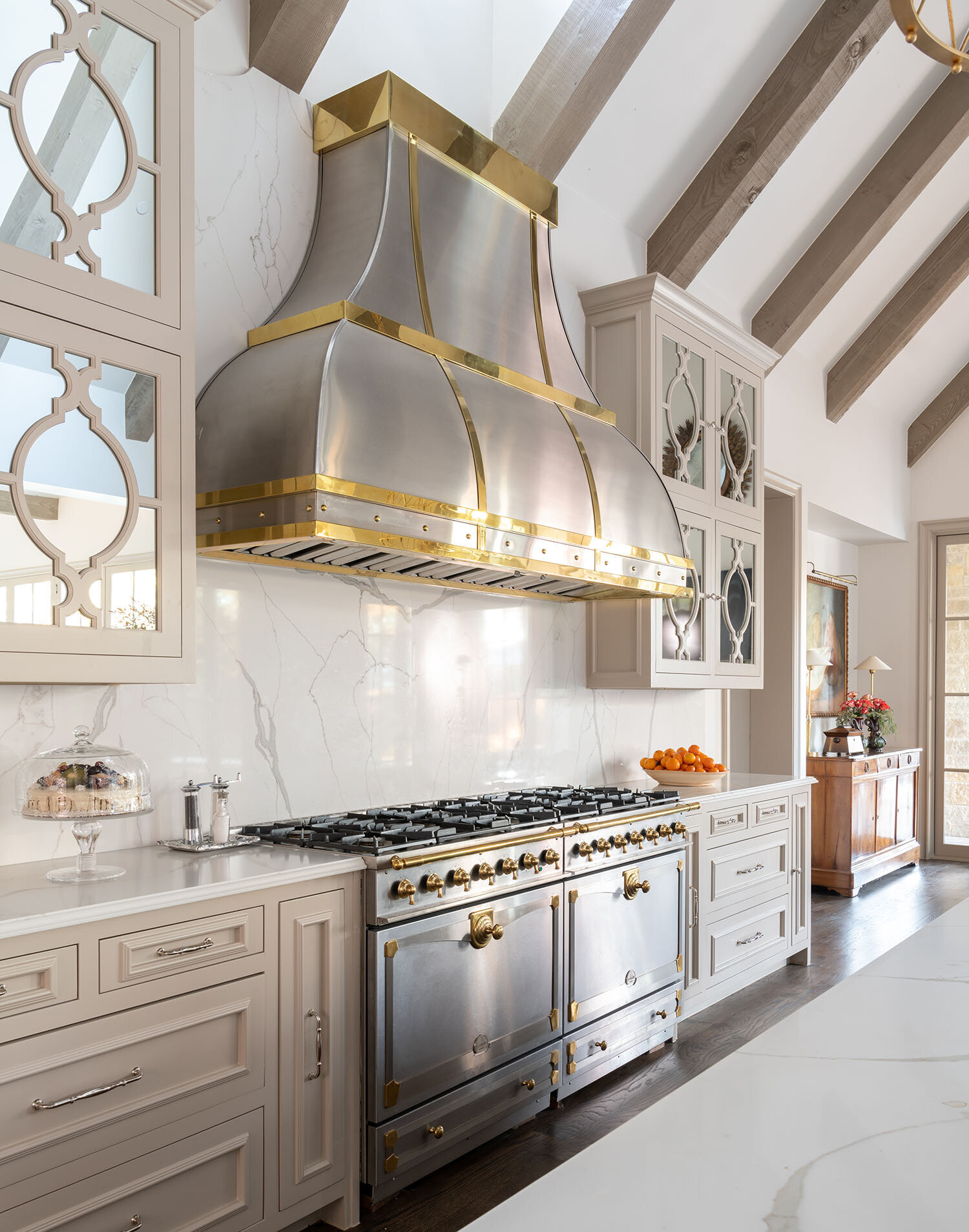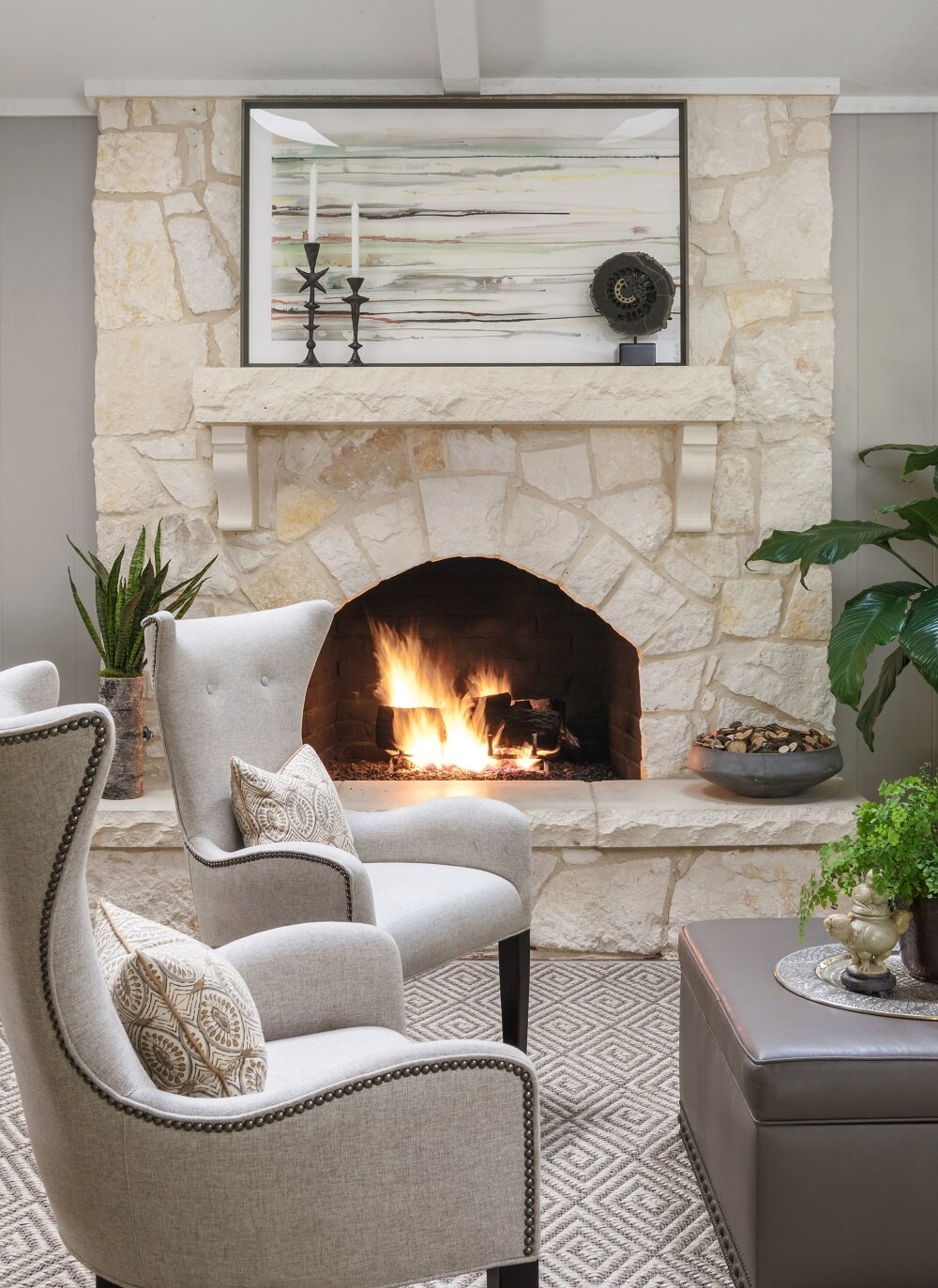This double range and custom vent hood, both made out of steel and brass, form a focal point for the kitchen we designed in a Dallas home.
If you’re worried that one of your rooms has too much going on, it might be because you don’t have a focal point. The term ‘focal point’ will be familiar to our artistic readers: in a photograph, the focal point is the part of the picture where the lens is focused. In a painting, it’s the point where the viewer’s eye is drawn. Interior designers use the term focal point to indicate the place where your eyes first land when you enter a room. For those new to this concept, here is a set of guidelines for using the things you already own to create new focal points.
The beams of this vaulted ceiling act as one focal point while also leading the eye to another: the round wall art.
One way to start identifying potential focal points is to make note of any architectural features you have. Fireplaces, built-in bookcases, vaulted ceilings, mantles, free-standing bathtubs, oven hoods, and large windows will usually be the focal points for their respective rooms.
When you don’t have an architectural focal point in the room, you’ll need to create one with your decorating choices. Statement furniture, paintings, coffee tables, rugs, backsplashes, collections, or lighting fixtures can all be focal points. Whatever you choose, it needs to be in the line of sight for any visitor stepping into the room.
Coffered ceilings, such as this one, make an excellent focal point for entryways, dining rooms, or formal living rooms.
Ideally, a focal point should contrast with its surroundings and command attention, rather than blend in. Different focal points require different approaches:
If your windows are the focal point, don’t crowd them with heavy drapes. Another thing to consider is that unless you’re looking out at a brightly lit city skyline, your windows won’t be visually interesting after the sun goes down. If your room is large enough, add another focal point (such as a piece of art) to keep things interesting at all times of the day.
To ensure your mantle will be a strong focal point, decorate it with plenty of eye-catching accessories.
In an entryway, the door is typically the focal point. Paint it a contrasting color from the rest of the walls to emphasize it.
Possible focal points for the bedroom can be the bedding, the headboard, or the wall behind the bed.
In open-concept layouts, you can give each area its own focal point. You may want to add another focal point between the individual seating areas to bring everything together.
For dining rooms, a light fixture or a showy table setting can be focal points.
Draw attention to your ceiling with a paint or stain color that isn’t seen anywhere else in the room.
Adding accessories to the mantle of your fireplace will help to make sure that it becomes a focal point for your room.
A large room can accommodate multiple focal points, but a small room should never have more than two. In a living area with a beautiful view, for example, both the fireplace and the windows can be focal points. To balance more than one focal point, establish seating areas or groups of accessories around each of them.
One of the focal points should always be more dominant than the others, so make sure you’re using paint or lighting to ensure that the viewer will look at it first. To make whitewashed furniture pop, put a dark wall color behind it; inversely, put your dark statement furniture in front of a white wall.
You can also try flanking your focal point with plants, lamps, or vases on either side to give that part of the room some “weight.” Height is another way to help your focal point assert itself. If your focal point is an armoire or desk, and there’s open wall space above, hang a tall mirror over it. Patterns often have visual movement, so a patterned rug can actually help “lead” to a focal point when the lines of the pattern are going in the same direction.
If you have a side table that you'd like to use as a focal point for your room, try hanging a tall mirror over it.
Even if a room is filled with the most beautiful objects, without a clear focal point, it won’t feel cohesive. Creating focal points is a skill any interior designer needs to know to do well in their profession. With some of these designer tips in mind, you’re well on your way to giving your rooms a professional touch.
Because this farmhouse kitchen is mostly white, a black fireplace screen with animal figures was used as a backsplash to command attention.
If you have some ideas on how you want to redesign your rooms but could still use some help, feel free to get in touch with us. The best ways to reach us are by calling our Dallas office at 214-651-7665 or sending an email to info@chambersinteriors.com.






